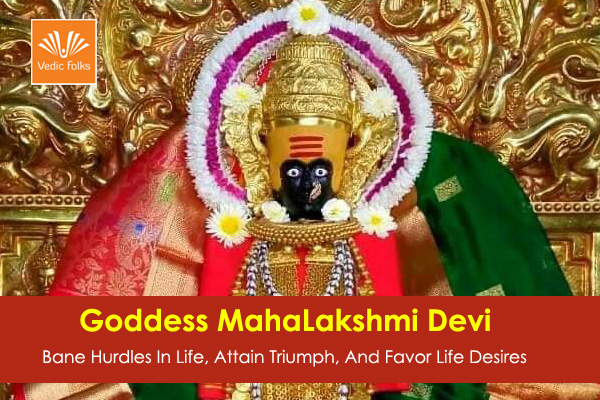Goddess MahaLakshmi Devi
The metropolis of Kolhapur (Karaveerapur as it turned into known in ancient times) is situated inside the Western state of Maharashtra. In the Kolhapur Mahatmya and additionally in some of Puranas, it is mentioned as Dakshin Kashi attributable to its historic lifestyle and non secular influences. Different dynasties ruled it at distinct periods although it attained its stature of greatness below the Maratha rule of Chhatrapati Shahu Maharaj. One of the most essential pilgrim centre which draws thousands and thousands of pilgrims from all around the global is the Goddess Mahalakshm Tuljapur, Vani and Mahur which is thought to steer one to salvation and fulfilment of all desires. The temple changed into said to had been constructed within the Chalukya period (550 AD to 660 AD) by using King Manglesh as can be obvious from the style of sculpture. However in the 8th century the historic temple becomes destroyed by way of an earthquake and several ruins of the former shape may be observed today. In the 9th century, it became restored and beautified by the Shilahara Yadavas. The remains can be observed inside the historic idol that is determined in a small structure subsequent to the stairs. On the alternative facet of the stairs is the sculpture of the Varaha (boar) Avatar of Lord Vishnu carrying Mother Earth on its tusk. The boar additionally represented the emblem of the erstwhile Chalukyan empire. Behind the sculpture of the boar is an inscription of a Shivalinga, a bull and a sword. The stays of masterpieces of art include a part of a spire with the sun disc having 12 signs of the zodiac. Above this spire is an intricately carved panel of Jain Tirthankars and on the left side is a sculpture of moon and standing eagle with its fingers joined together. On the primary storey is an idol of Lord Ganesha with stone carving wearing the face of a ferocious lion which was the symbol of the Chalukyan dynasty. There is likewise a sculpture of Vyala that is a composite mythical leonine beast with horns found near the staircase leading to the superstructure. The stays of two sculptures certainly one of a bull and the opposite of a ram may be visible on either side of the principle entrance. Below the lamp pillars is the snake sculpture and Shivalingas which portray the Badami (Bijapur) fashion of temples built within the Chalukyan era
How The Temple Become Famous For Architecture
Since the temple turned into reconstructed and restored in the course of successive centuries, the influence of numerous architectural varieties of different eras may be seen. From the 6th to the 13th century, diverse additions to the unique temple have been made. The temple measures 350 feet through 225 ft with a peak of 35 feet with the main spire at 45 ft. The temple is stated to be of Hemadpanthi fashion after Prime Minister Hemadri Yadav of the Yadav dynasty. This fashion involves the usage of locally available black stone and lime in its construction. The Goddess Mahalakshmi temple also depicts the Vesar fashion of architecture that’s a confluence of Nagar and Dravidian patterns which comprises of a major temple with a complicated having several small shrines. The base of such temples is big name shaped (called Tarakapeeth, taraka which means superstar and peeth which means base) with angular contours and 24 to 32 angles to the big name shaped structure. At the bottom there are sculptures of elephants at diverse entrances and corners of this temple.
Significance
Sage Bhrigu changed into one of the Saptarishis and the Manas Putra of Lord Brahma. Once a brilliant Maha Yajna became being performed with the aid of many first rate sages and a decision couldn’t be taken as to which God amongst Lord Brahma, Lord Vishnu and Lord Shiva became the greatest in order to be provided the number one seat inside the Yajna. Sage Bhrigu decided to test each of them and decide at the greatest. On accomplishing Brahmaloka, he displayed disrespect for Lord Brahma who furious with him wanted to punish him, however became restrained via his consort Goddess Saraswati. Unhappy, Sage Bhrigu left the place cursing that no one could worship Lord Brahma in the world due to which there are only a few Lord Brahma temples on the planet to this day. Sage Bhrigu then got down to Kailash and become stopped by using Nandi from entering interior as Lord Shivaand Goddess Parvati have been in their non-public chambers. Bhrigu then cursed Lord Shiva that he could simplest be worshipped within the Linga form. Finally, Bhrigu got down to Vaikunta to check Lord Vishnu. When he entered, he saw Lord Vishnu in deep sleep and while he did no longer awaken and well known Bhrigu, the sage kicked him on his chest (stated to be the location wherein Goddess Mahalakshmi resides). Vishnu at once wakened and instead of getting irritated rushed to sage Bhrigu and asking him if his foot turned into paining because of the strike began to massage it. During this act, the Lord is stated to have squashed the greater eye that became gift in the only of Bhrigu’s foot symbolising the sage’s egotism. Sage Bhrigu straight away declared that Vishnu became the greatest among the trinity. But Goddess Mahalakshmi, Lord Vishnu’s consort was livid at Bhrigu’s temerity and when she saw Lord Vishnu’s inaction in opposition to Bhrigu, she left Vaikunta and went to Kolhapur where she discovered strict penance for many years and remained there till Lord Vishnu went looking for her, which resulted within the legacy of Lord Balaji and Goddess Padmavati. Her presence is said to ensure by no means finishing prosperity to the city of Kolhapur.
Benefits
- Abundance of wealth and prosperity.
- Bless material riches.
- Bless stable financial situations.
- Removes poverty, and stable money flow.
- Removes all kinds of dosha in a horoscope.

















